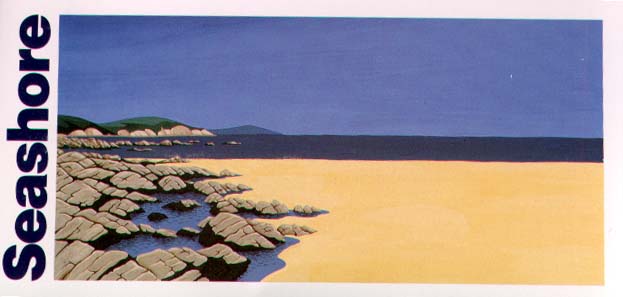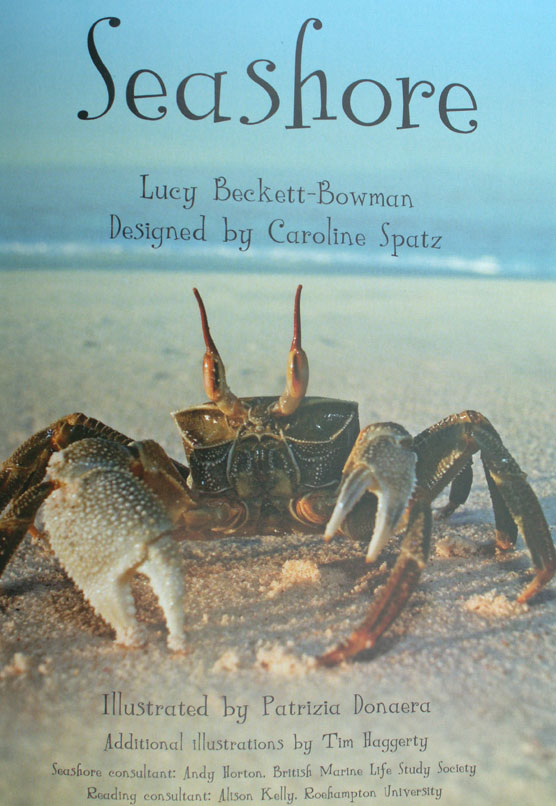
 |
ROCKPOOLING: Notes
for Teachers
Shorewatch
Biological Recording Information Page
Teacher:
“How can I educate the children about the sea and seashore if the information is not in books?”
Reply:
“Well you can go down to the beach a thousand times and find out for yourself, or/& you can join the British Marine Life Study Society and share in experiences of others and make your own contributions.”
The following web pages may also be useful for parents and children:
Aquaria: From Rockpool to Aquaria
Coastal Code
Ethics and Conservation on the Shore
Guidelines for Parents
MARINE
CONSERVATION STUDY PACK FOR SCHOOLS
by Carolyn Heeps and Sarah Welton
Marine Conservation Society
9 Gloucester Way, Ross-on-Wye.
Tel: 01989 566017 Sarah Welton
This up-to-date Conservation Study Pack is now available free to schools (£1 P&P) and is a specially designed starter pack for marine conservation in the classroom, intended for the National Curriculum (Key Stages 3 & 4) with a separate pack for the Scottish 5-14 Curriculum (Upper Primary and Lower Secondary).
The pack is contained in a cardboard folder and contains 20 A4 factsheets, some on a single sheet printed on both sides and others on 4 sides. It explores all the major issues of conservation interest concerning the seas, e.g. sewage pollution, marine mammals and their management, fisheries and wildlife. The pack contains lots of information and is well designed in blue ink, with line drawings, maps and graphs. It certainly fulfils a need, judging by the number of enquiries I receive. There is no bibliography, but the Marine Conservation Society have a large number of books for sale, including the most important books on the marine environment.
The Scottish Study Pack is available as a separate pack.
The scope does not extend to the study of wildlife, and for seashore
study the next pack is to be recommended.
MARINE
ENVIRONMENTAL EDUCATION RESOURCE PACK
Devon Wildlife
Trust 1997
Tel: 01392 279244 Richard White
This marine environmental resource pack is in a cardboard folder and
designed for teachers who take children down to the seashore to explore
the life in pools and under rocks at low tide.
It is divided into ten modules which provide a structured guide
to exploration of the seashore. I do not know whether a structured guide
is the best thing for the first visit, but the Devon Wildlife Trust have
years of experience of taking students of all ages down to Wembury Bay
and other interesting areas of the Devon coast, and the information gives
plenty of ideas for the teacher.
One of the A4 sized cards is marked IMPORTANT and I know from experience that detailed preparation is necessary before taking a party down to the shore. This information is omitted from most seashore guides, so for this page alone the pack is essential.
My advice to teachers would be to buy this pack plus one of the simpler guides to identification of the animals and seaweeds on the shore, and with a bit of thought on what disasters might befall the more adventurous of the kids, a good time will be had by all.
The text seems to be linked to the National Curriculum. I would image that it is designed for school children up to 12 years, although if this is the case the teacher may have to translate some of the information into a simpler language for younger children.

The outside cover is in colour with an attractive computer generated
design, but the text and drawings are in black and white. It is a bit cumbersome
to take down to the beach and is not waterproof, so the Collin's Watch
Guide to the Seashore, reviewed below, may be a better bet. The best choice
is to buy both.
Collins
Watch Guide No. 5
Seashore
by Jean-Baptiste de Panafieu
Translated by Josephine Weightman
Harper Collins 1997
ISBN 0-00-220088-0
Recommended Price: £5.99
Parents taking their children down to a rocky shore are likely to be all at sea and unable to put a name to the small fish, crabs and other animals. This guide should enable parents to answer the questions of the younger children, and older children will be able to understand the book and find out about the seashore for themselves. The new series of Collins Watch Guides are very readable and full of colour illustrations.
The Seashore Book contains 48 pages packed with all the important information. It will fit comfortably in a pocket and has a glossy surface that will resist the occasional splash. It is an ideal book for the newcomer to the seashore. Common names are used and scientific names are omitted.
Collins
Watch Guide No. 3
Whales, Dolphins and Seals
by Francois Moutou
Translated by Josephine Weightman
Harper Collins 1997
ISBN 0-00-220089-9
Recommended Price: £5.99
The sea mammals, which include the dolphins, porpoises and otters
of the European coast, are usually confined to remote coasts uninhabited
by man, so this book will not be as practical as the first volume. However,
for the inquisitive youngster this book brings all the important information.
Both books contain an index and a small glossary.
EXPLORATION SEASHORE
An Activity Guide for use with Children
This is an earlier initiative by Evan Jones and Sally Rogers, funded by themselves and distributed through the Marine Conservation Society. Evan is a teacher (at King's Manor, Shoreham-by-Sea) and this is obvious in the style which gets across to the younger student of the seashore. There is also bits of information and guidelines for teachers. Worth a look if you can obtain a copy. May be the best bet for primary schools.
The illustrations are in black and white, but
the publication is glossy and water resistant. It is A4 sized. Pic.
by Leslie Jackman
Dragon's
World Children's Books
ISBN
1-85028-295-1
PLANET OCEAN
by Brian Bett
Portland Press 1977
RRP £6.99
ISBN 1 85578 094 1
This is a guide to the life in the deep oceans for the primary school
child. Quote: "As the ocean covers nearly three-quarters of our planet,
it should be called PLANET OCEAN." This is a good book for the first school
library, where the deep sea is probably not covered by an existing book.
The book is 32 pages long and mostly in simple enough language for a six
year old, but there are some big words like hydro-thermal vents ('smokers').
PS. Could they be called 'hot water gushers', or 'volcanoes'.
One Small Square
SEASHORE
3D Window into the Fascinating World of Nature
Virgin Sound and Vision CD-ROM
RRP £29.99
This CD-ROM is designed for the very young, up to the age of about 12.
It is as much about becoming familiar with the workings of a computer program
as a tool for understanding the seashore. The real problem as far as British
purchaser is concerned is that American fauna is the subject matter. Although,
there is some overlap, with some of the animals found between the
tides on the American coast similar to ours, this CD-ROM cannot be recommended
to the British purchaser. The best bet, at the present time, is to purchase
one of several books on the seashore specially written for the younger
age group.
The Hermit Crab game is good fun for children for about half
an hour. There is a mistake in the graphics which perhaps some of our members
could spot, but it would be missed by most people.
 |
Seashore by Lucy Beckett-Bowman Consultant:
Andy
Horton
Usborne
Beginners Series
ISBN
978-0-7460-8864-7
|
BEST![]() BOOKS
OF 1998
BOOKS
OF 1998
A 'Rockpooler' is a naturalist explorer of the shore.
Rockpooling Reports in Glaucus are detailed
studies introducing a visitor to various shores around the British Isles.
The idea is to give rockpoolers information that may help them when visiting
shores of which they are not familiar.

BRITISH MARINE WILDLIFE FORUM PAGE |

|
|
|
|
|
News 2018 |
Membership Form |
|